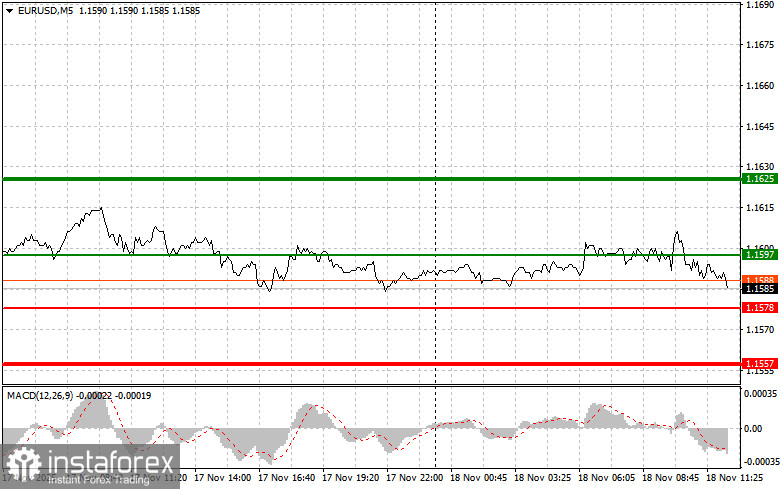Trade Analysis and Recommendations for the Euro
The price test of 1.1605 occurred at a moment when the MACD indicator had just begun moving upward from the zero mark, which confirmed a correct buy-entry point for the euro. However, the trade resulted in losses, as the EUR/USD pair ultimately failed to show any upward movement.
The limited number of economic reports from the eurozone led to reduced EUR/USD volatility, resulting in the formation of false market entry signals. With fresh economic data from the eurozone and the U.S. expected in the coming days, the situation should become clearer. Many traders are eagerly awaiting labor market and inflation reports, hoping for clear indicators of the economic situation in the U.S. and Europe.
This afternoon, attention will shift to U.S. NAHB Housing Market Index data and manufacturing orders. The NAHB index, in particular, helps assess the sentiment of construction companies. Positive readings may support dollar growth, while weaker numbers may negatively impact the U.S. currency. At the same time, FOMC members Michael S. Barr and Thomas Barkin will deliver speeches. Any hints of possible changes in interest rates could cause significant fluctuations in the currency market and, in particular, affect the EUR/USD rate.
As for the intraday strategy, I will rely mainly on scenarios No. 1 and No. 2.

Buy Signal
Scenario No. 1: Today, buying the euro is possible when the price reaches the level around 1.1597 (green line on the chart), with a target of rising to 1.1625. I plan to exit the market at 1.1625 and also open a sell position in the opposite direction, expecting a 30–35 point move from the entry point. Counting on euro growth today will only be justified after dovish rhetoric from Fed officials.Important! Before buying, make sure the MACD indicator is above the zero line and only beginning to rise from it.
Scenario No. 2: I also plan to buy the euro today in case of two consecutive tests of the 1.1578 price level at a moment when the MACD is in the oversold area. This will limit the downward potential of the pair and trigger a reversal upward. Growth toward the opposite levels of 1.1597 and 1.1625 can then be expected.
Sell Signal
Scenario No. 1: I plan to sell the euro after the price reaches 1.1578 (red line on the chart). The target will be 1.1557, where I intend to exit the market and immediately buy in the opposite direction (expecting a 20–25 point rebound). Pressure on the pair will return today in the event of a hawkish stance from Fed representatives. Important! Before selling, make sure the MACD indicator is below the zero mark and only beginning to decline from it.
Scenario No. 2: I also plan to sell the euro today if there are two consecutive tests of the 1.1597 price level when the MACD indicator is in the overbought area. This will limit the pair's upward potential and trigger a reversal downward. A decline toward the opposite levels of 1.1578 and 1.1557 can be expected.

Chart Legend:
- Thin green line – entry price at which the instrument can be bought
- Thick green line – suggested Take Profit area or level for manually fixing profit, as further growth above this mark is unlikely
- Thin red line – entry price at which the instrument can be sold
- Thick red line – suggested Take Profit area or level for manually fixing profit, as further decline below this mark is unlikely
- MACD indicator – when entering the market, it is important to use overbought and oversold areas as guidance
Important
Beginner Forex traders must make entry decisions very carefully. Before the release of important fundamental reports, it is best to stay out of the market to avoid sudden price swings. If you choose to trade during news releases, always place stop-loss orders to minimize losses. Without stop-loss orders, you can lose your entire deposit very quickly—especially if you ignore money management and trade large volumes.
And remember, successful trading requires a clear trading plan, such as the one presented above. Spontaneous trading decisions based solely on the current market situation are an inherently losing strategy for intraday traders.





















